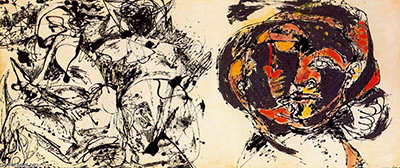Jackson Pollock painted his now famous Portrait and a Dream back in 1953. The painting depicts two images that are side by side that the art world recognised as being Pollock's abstract self portrait.
It is believed that Pollock wished to portray his inner self on canvas, and frequently did so in his various sketches and drawings. He was well known for being unable to distinguish himself from his paintings, with the two worlds being constantly combined.
The painting on the right of the canvas looks as though it is obscured by a type of mask, as we are only able to see part of the face. The face that was painted is also very recognisable in some of Pollock's other works, and has been linked on many occasions to his exploration of the Jungian theory of mind.
Portrait and a Dream, blurs the world of art and the self, with the two worlds fused together on canvas. Although the work is a self portrait, it has been drawn almost savagely and appears that Pollock himself was releasing his emotional energy while he created his art.
The black lines and blotted colours all contribute to the energy of the image that seems to be forever moving. The colours that he chose for the head, almost appear to have been thrown onto the page and create an almost non human quality to the self portrait.
The dream element is depicted om the left of the canvas. What the observer sees is a mass of black and white tangled bodies.
Although Pollock referred to this image as representing the 'dark side', it has never been made clear what the image truly represents. What is obvious is that the dark side of the painting is almost gothic and horrific in nature.




